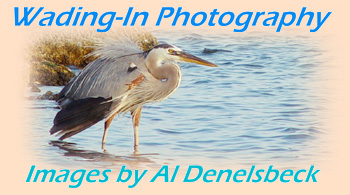
Photographers (in alphabetical order) – Not all of them deal with nature and wildlife, but they all offer some strong images and particular styles.
Some sites also contain pages of hints, tips, and guides, which can be a valuable resource for photographers of any level.
So bookmark them, and poke around every once in a while – new galleries and additions always happen along, it's what we strive for.
Gene Anderson, http://www.designsinlight.com – Gene likes strong color and sweeping vistas, and produces some stunning landscape photos. He also uses his talent to help support various nonprofit humanitarian organizations, and there can never be too much of that.
Skip Pudney, https://www.flickr.com/photos/skipp35/ – Skip is both a photographer and writer specializing in the deep woods, mostly in the Carolinas, and in the western states. Take a deep breath while viewing some of his forest images, and you'll swear you can smell the leaves and water.
Al Jacobson, http://www.aljacobs.com – Al's site is one of the best resources for any aspiring wedding photographer (and probably quite a few experienced ones!). He's put years of experience into his guides, and he tells everyone what to expect and how to handle it. A must-visit if you're considering the wedding trade, or even if you're planning your own wedding. And don't miss his gadget section.
Steve Kramer's "PhotoEnvisions," http://www.photoenvisions.com – Steve lives in Thailand but travels extensively, and presents his subjects with an eye towards culture and journalism. And it's clear from many of his portraits that he relates well to the people he meets. Steve has put this to good use as both a teacher and a feature photojournalist, who admits to being delightfully busy.
Bert Sirkin, http://www.photobert.com/ – Bert is another one of these people who have traveled extensively, and many of his images show off the grandeur of the western deserts and Alaska. Bert's images often remind me irresistibly of meticulous paintings. He also hosts some pages of tips, links, and excellent cheatsheets for the Nikon line of cameras.
Alex Wild's " Myrmecos," http://myrmecos.net/ – Alex Wild's photo blog and gallery. Alex is one of (if not "the")
foremost photographers of ants around. He also teaches workshops and
guest blogs on Scientific American.
Reference and just-plain-handy sites:
North Carolina Zoological Park, Asheboro, http://www.nczoo.org
North Carolina Botanical Gardens, Chapel Hill, http://ncbg.unc.edu/
Sarah P. Duke Gardens, Durham, http://www.hr.duke.edu/dukegardens/
North Carolina Museum of Life & Science , Durham, http://www.ncmls.org/
North Carolina Museum of Natural Sciences, Raleigh, http://naturalsciences.org/
North Carolina Aquariums, http://www.ncaquariums.com/
Sylvan Heights Bird Park, http://shwpark.com/
Florida Keys Wild Bird Center, http://fkwbc.org/
Venice Audubon Society Rookery, http://www.veniceaudubon.org/rookery.html
Wakodahatchee Wetlands, http://www.pbcgov.com/waterutilities/wakodahatchee/
Callaway Gardens (west Georgia), http://www.callawaygardens.com/
North American Nature Photography Association, http://www.nanpa.org/
Nature Photographers Online Magazine, http://www.naturephotographers.net/
Cradoc FotoBiz photographers' software, http://www.cradocfotosoftware.com/
B&H Photo/Video, http://www.bhphotovideo.com/
Seeing what's happening in the night sky, http://www.heavens-above.com/
Equipment is shown in the photo specs. Primarily Canon equipment, though some of my older stuff was shot on Olympus (or when I really want to travel light.) I've also branched out into medium format with Mamiya 645 equipment. Everything is carried in belt packs, with the exception of the tripod – straight down my back with two straps, weight balanced and distributed. I have a lot of esoteric and homemade accessories, things I've suited to fit my own style or needs – and because I'm cheap. Photographic equipment can be ridiculously overpriced sometimes, and I don't like playing by those rules ;-)
Macro work is accomplished in many ways, from dedicated macro lenses (Sigma 105mm f2.8 and Mamiya 80mm f4) to extension tubes, bellows (Vivitar Bellows with Vivitar 135mm f2.8 and Olympus 50mm f1.4,) lens reversing and lens stacking. Since depth-of-field continues to reduce with higher magnification, shooting at small apertures is paramount, which means most macro work is done with strobes, often off-camera with a sync cord, and occasionally with a softbox. Supplemental lighting and bounce cards are also used. For more info, see my macro tips page and any blog posts that come up under the search term "macro photography".
Film is mostly Fuji Provia 100F and Velvia, because I can depend on the results, but I'll try out anything. Kodak E100VS and SW have their uses, as do Fuji Astia and Sensia – all of these are slide films. For print, I often use Fuji Superia 400 and occasionally Reala, Fuji NPH when I'm doing people, and several different Ilford films for B&W work.
Digital Work is (or has been) accomplished through a variety of cameras, from a Sony F717 through a Canon Pro 90 IS to a Canon 7D. Scanning of slides is done through a Minolta Scan Dual III, with editing done in Adobe Photoshop 6.0m or GIMP 2.8
This website was created and recreated over a large period of time, using several different programs, by a guy (me) that learns as he goes. At any time you may notice changes in format between different sections, and this is simply growing pains. The curse of making a large site – you end up remaking it all when you see the previous mistakes ;-).
